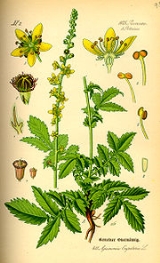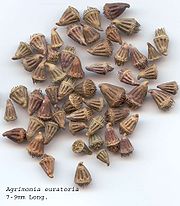
Agrimonia eupatoria
Encyclopedia
Agrimonia eupatoria is a species of agrimony
that is often referred to as common agrimony, church steeples or sticklewort.
The whole plant
is dark green with numerous soft hairs. The soft hairs aid in the plant's seed pods sticking to any animal or person coming in contact with the plant. The flower spikes have a spicy odor like apricots.
A. eupatoria is a foodplant for the caterpillar
s of the snout moth Endotricha flammealis
.
, perennial herbaceous plant
and reached heights of up to 100 centimeters. Its roots are deep rhizome
s , from which spring the stems. It is characterized by its typical serrated edged pinnate
leaves
.
flower has fivefold radial symmetry. There are five sepal
s present . There are five yellow, rounded petal
s. The petals and the five to 20 stamen
s rise above the tip of the flower cup . The two medium-sized carpels in the flower cups are sunk into, but not fused with it . The flowers with their abundant pollen supply attract hoverflies , flies
and honey bees. The pollinated flowers develop fruits with burs . These attach to passing grazing animals such as cattle , sheep and deer and are spread over a large area.
. It is ruled astrologically by Cancer
, according to Nicholas Culpeper
. Common folklore held that it could cure musket
wounds, and ward off witchcraft
.

advised the use of Agrimony as a cure for male impotence - saying it should be boiled in milk, and that it could excite a man who was "insufficiently virile;" it also states that when boiled in Welsh beer it would have the opposite effect.
A. gryposepala
, the plant's North American relative, also has traditional medical uses.
Agrimony
Agrimonia, commonly known as Agrimony, is a genus of 12-15 species of perennial herbaceous flowering plants in the family Rosaceae, native to the temperate regions of the Northern Hemisphere, with one species also in Africa...
that is often referred to as common agrimony, church steeples or sticklewort.
The whole plant
Plant
Plants are living organisms belonging to the kingdom Plantae. Precise definitions of the kingdom vary, but as the term is used here, plants include familiar organisms such as trees, flowers, herbs, bushes, grasses, vines, ferns, mosses, and green algae. The group is also called green plants or...
is dark green with numerous soft hairs. The soft hairs aid in the plant's seed pods sticking to any animal or person coming in contact with the plant. The flower spikes have a spicy odor like apricots.
A. eupatoria is a foodplant for the caterpillar
Caterpillar
Caterpillars are the larval form of members of the order Lepidoptera . They are mostly herbivorous in food habit, although some species are insectivorous. Caterpillars are voracious feeders and many of them are considered to be pests in agriculture...
s of the snout moth Endotricha flammealis
Endotricha flammealis
Endotricha flammealis is a moth of the family Pyralidae.It is found in Europe and nearby regions: its range extends to Iran , to Lebanon and Syria, and to the Maghreb. The proposed subspecies carnealis and several supposed varieties seem to be indistinguishable from typical individuals found in...
.
Description
Vegetative characteristics
The common agrimony grows as a deciduousDeciduous
Deciduous means "falling off at maturity" or "tending to fall off", and is typically used in reference to trees or shrubs that lose their leaves seasonally, and to the shedding of other plant structures such as petals after flowering or fruit when ripe...
, perennial herbaceous plant
Herbaceous plant
A herbaceous plant is a plant that has leaves and stems that die down at the end of the growing season to the soil level. They have no persistent woody stem above ground...
and reached heights of up to 100 centimeters. Its roots are deep rhizome
Rhizome
In botany and dendrology, a rhizome is a characteristically horizontal stem of a plant that is usually found underground, often sending out roots and shoots from its nodes...
s , from which spring the stems. It is characterized by its typical serrated edged pinnate
Pinnate
Pinnate is a term used to describe feather-like or multi-divided features arising from both sides of a common axis in plant or animal structures, and comes from the Latin word pinna meaning "feather", "wing", or "fin". A similar term is pectinate, which refers to a comb-like arrangement of parts...
leaves
Leaf
A leaf is an organ of a vascular plant, as defined in botanical terms, and in particular in plant morphology. Foliage is a mass noun that refers to leaves as a feature of plants....
.
Generative characteristics
The short-stemmed flowers appear from June to September , in long, spike-like, racemose inflorescences. The single flower has an urn-shaped curved flower cup , the upper edge has several rows of soft, curved hook-shaped bristles, 1 to 4 millimeters long. The hermaphroditeHermaphrodite
In biology, a hermaphrodite is an organism that has reproductive organs normally associated with both male and female sexes.Many taxonomic groups of animals do not have separate sexes. In these groups, hermaphroditism is a normal condition, enabling a form of sexual reproduction in which both...
flower has fivefold radial symmetry. There are five sepal
Sepal
A sepal is a part of the flower of angiosperms . Collectively the sepals form the calyx, which is the outermost whorl of parts that form a flower. Usually green, sepals have the typical function of protecting the petals when the flower is in bud...
s present . There are five yellow, rounded petal
Petal
Petals are modified leaves that surround the reproductive parts of flowers. They often are brightly colored or unusually shaped to attract pollinators. Together, all of the petals of a flower are called a corolla. Petals are usually accompanied by another set of special leaves called sepals lying...
s. The petals and the five to 20 stamen
Stamen
The stamen is the pollen producing reproductive organ of a flower...
s rise above the tip of the flower cup . The two medium-sized carpels in the flower cups are sunk into, but not fused with it . The flowers with their abundant pollen supply attract hoverflies , flies
Fließ
Fließ is a municipality in the Landeck district and is located5 km south of Landeck on the upper course of the Inn River. It has 9 hamlets and was already populated at the roman age; the village itself was founded around the 6th century. After a conflagration in 1933 Fließ was restored more...
and honey bees. The pollinated flowers develop fruits with burs . These attach to passing grazing animals such as cattle , sheep and deer and are spread over a large area.
In folklore
Agrimony has been stated to have medical and magical properties since the time of Pliny the elderPliny the Elder
Gaius Plinius Secundus , better known as Pliny the Elder, was a Roman author, naturalist, and natural philosopher, as well as naval and army commander of the early Roman Empire, and personal friend of the emperor Vespasian...
. It is ruled astrologically by Cancer
Cancer (astrology)
Cancer is the fourth astrological sign in the Zodiac. It is considered a water sign and one of four cardinal signs. Cancer is ruled by the Moon. Individuals born when the Sun is in this sign are considered Cancerian individuals...
, according to Nicholas Culpeper
Nicholas Culpeper
Nicholas Culpeper was an English botanist, herbalist, physician, and astrologer. His published books include The English Physician and the Complete Herbal , which contain a rich store of pharmaceutical and herbal knowledge, and Astrological Judgement of Diseases from the Decumbiture of the Sick ,...
. Common folklore held that it could cure musket
Musket
A musket is a muzzle-loaded, smooth bore long gun, fired from the shoulder. Muskets were designed for use by infantry. A soldier armed with a musket had the designation musketman or musketeer....
wounds, and ward off witchcraft
Witchcraft
Witchcraft, in historical, anthropological, religious, and mythological contexts, is the alleged use of supernatural or magical powers. A witch is a practitioner of witchcraft...
.

Traditional herbal medicine
The 9th-century text Bald's LeechbookBald's Leechbook
The Leechbook of Bald is an Old English medical text probably compiled in the ninth-century, possibly under the influence of Alfred the Great's educational reforms....
advised the use of Agrimony as a cure for male impotence - saying it should be boiled in milk, and that it could excite a man who was "insufficiently virile;" it also states that when boiled in Welsh beer it would have the opposite effect.
A. gryposepala
Agrimonia gryposepala
Agrimonia gryposepala is a small flowering plant of the rose family , which is native to North America and was used by various indigenous peoples to treat medical problems such as diarrhea and fever.-Name and description:Agrimonia gryposepala Agrimonia gryposepala (also known as Tall hairy...
, the plant's North American relative, also has traditional medical uses.

